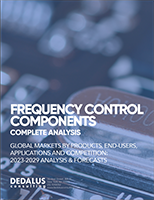The market for components, equipment and devices needed for the integration and expansion of AI infrastructure and applications will see growth rates in the double digits – from 15-35% depending upon the equipment market – over the next several years.
In terms of frequency control and timing components, the growth of AI will have a direct impact on both the quartz-based and non-quartz-based markets. As covered by Dedalus Consulting, the frequency control and timing components market will top $12 billion globally in 2024 across all markets. Each of these markets will continue to be integral in the implementation of AI.
Current Advancements
Manufacturers are already pushing the envelope in terms of miniaturization and integration, creating timing components that are smaller, more robust, and consume less power. For instance, micro-electro-mechanical systems (MEMS) timing devices are now a viable alternative to traditional quartz crystal oscillators, bringing with them their advantages in terms of size and power efficiency.
Advancements in processing, storage solutions, networking equipment, telecom infrastructure, power supply and management, as well as backup and redundancy systems are on the horizon. Assessing the growth trajectories of these markets necessitates evaluating technological innovations, market needs, industry shifts, and regulatory dynamics.
- Processing:
AI has already been pushing the development of more powerful and efficient processors, including the integration of specialized AI accelerators such as GPUs (Graphics Processing Units) and TPUs (Tensor Processing Units) to enhance computational capabilities for AI applications. This market is expected to witness robust growth, with estimated compound annual growth rates (CAGR) ranging from 20 – 25% over the next several years.
- Storage Solutions:
The development of high-capacity and high-speed storage devices such as SSDs (Solid State Drives) and NVMe (Non-Volatile Memory Express) storage will enable faster data access and processing for AI workloads. This growth will be fueled by the exponential increase in data generated by AI workloads and the need for efficient data storage and retrieval systems.
- Networking Equipment:
AI will enhance networking equipment by optimizing network traffic routing, improving bandwidth management, and enhancing security through intelligent threat detection and prevention mechanisms. This will result in more efficient and secure communication networks capable of handling the increasing data demands of AI-driven applications. This growth will be driven by the proliferation of applications such as edge computing, IoT (Internet of Things), and 5G networks, which require advanced networking capabilities to support real-time data processing and communication.
- Telecom Infrastructure:
AI technologies will play a crucial role in optimizing telecom infrastructure, including the deployment of algorithms for network optimization, predictive maintenance, and dynamic resource allocation. This will improve network reliability, reduce latency, and enhance overall performance for telecommunications services. This growth will be driven by investments in 5G infrastructure, cloud-based services, and AI-driven network optimization solutions to meet the increasing demand for high-speed and reliable communication networks.
- Power Supply and Management:
AI-enabled power supply and management systems will offer intelligent energy management solutions, optimizing power usage based on real-time demand and workload requirements. This includes the development of predictive maintenance systems to enhance the reliability and efficiency of power supply infrastructure. This growth will be driven by the adoption of smart grid technologies, renewable energy integration, and energy management solutions to optimize power usage and reduce carbon emissions.
- Backup and Redundancy Systems:
AI will introduce intelligent data replication and backup strategies based on predictive analytics. This will enable proactive data protection measures, ensuring data integrity and availability in the event of system failures or disasters. This growth will be driven by increasing data security concerns, regulatory requirements, and the need for reliable data protection solutions in the face of cyber threats and system failures.
AI Demand Driven by End Users
The demand for AI-enhanced timing components is propelled by end users' needs, especially in telecommunications and the Internet of Things (IoT). The 5G revolution, with its strict timing requirements, and the anticipated IoT expansion underscore the necessity for intelligent timing solutions.
- Telecommunications: 5G and Beyond:
The transition to 5G has been perhaps the most significant driver of AI's adoption within the timing component industry. The stringent timing requirements of 5G networks, coupled with their dynamic and complex nature, make them a natural fit for intelligent timing solutions.
5G is not just faster than its predecessors; it is a fundamentally different type of network, where timing plays a crucial role in ensuring smooth and efficient data transfer. AI will be vital in optimizing and maintaining the timing requirements of these networks, especially as they become more prevalent and essential to our daily lives.
- The Internet of Things (IoT) Expansion:
The continued integration of the IoT is another sector that will benefit immensely from AI-enhanced timing components. With billions of devices expected to join the IoT ecosystem, the demand for precise and reliable timing will be unprecedented.
AI can help these devices not only maintain accurate timekeeping but also synchronize with one another seamlessly, enabling the collaborative behavior that makes the IoT so powerful. The implications of this for smart cities, industrial automation, and consumer electronics are immense and far-reaching.
- Emergent Technologies and Timing Demands:
Beyond existing applications, we can expect emergent technologies to set even more demanding timing benchmarks. For example, quantum computing—a technology that depends on extreme precision in its own timing—may rely on AI-enhanced timing systems to operate effectively.
Space exploration is another realm where advanced timing may be the difference between mission success and failure. The ability of AI to predict and mitigate timing issues in real-time could be the key to unlocking the potential of interplanetary travel.
Conclusion
AI's integration into timing components signifies a pivotal shift towards smarter, more reliable systems, and is a natural and necessary progression. This transition will not be without its challenges in design and manufacturing, but the industry is well-positioned to overcome them.
Dedalus Consulting (www.dedalusconsulting.com) has recently updated Frequency Control & Timing Components - Global Markets, End-Users, Applications & Competitors, the completely updated 13th edition of Dedalus’ in-depth research on the global frequency control and timing industry.
|
|
|
About Dedalus Consulting
Dedalus Consulting is a privately owned and independently operated market research publisher and consultancy.
In 1996, Dedalus Consulting emerged as a pioneering technology-driven consultancy. Founded with a singular focus on delivering unparalleled market research and competitive intelligence, our mission has always been clear: to provide high-value insights that empower our clients to navigate the dynamic landscapes of emerging and mature technology sectors.
Our clientele is as diverse as the industries we serve, ranging from Fortune 500 juggernauts to pioneering academic institutions. Whether you're shaping the future of technology or driving innovation, Dedalus Consulting is your indispensable partner in navigating the complexities of today's high-tech landscape.

